14.11.2019
A milestone payload for Ariane 5: the James Webb Space Telescope is prepared for liftoff with Arianespace
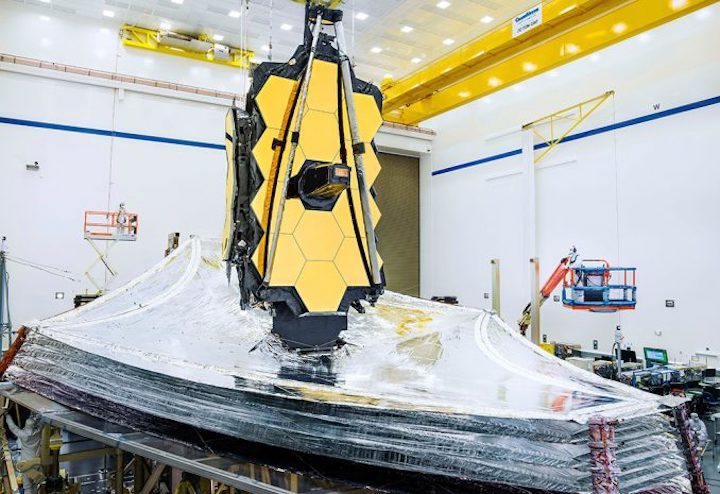
Technicians and engineers work to fully deploy the James Webb Space Telescope’s tennis court-sized sunshield at Northrop Grumman’s Redondo Beach, California facilities. Credits: NASA/Chris Gunn
With multiple pre-flight milestones achieved in recent months, the James Webb Space Telescope (JWST) – which will succeed the Hubble Space Telescope – is on course for its historic launch by Arianespace on an Ariane 5.
As the world’s premier space science observatory, the JWST will solve mysteries of the solar system, look for distant worlds, and probe the mysterious structures and origins of the universe. It is an international project led by the U.S. National Aeronautics and Space Administration (NASA) – along with its partners, the European Space Agency (ESA) and Canadian Space Agency (CSA).
Arianespace is performing the launch on behalf of ESA, within the agency’s scope of its collaboration with NASA. The mission – currently planned for 2021 – underscores Arianespace’s ability to serve institutional clients while also expanding humankind’s knowledge of the universe to make life better on Earth.
After deployment by Ariane 5 from the Spaceport in French Guiana, the JWST will travel to near the second Lagrange point (L2) of the Earth-Sun system (1.5 million kilometers from Earth, directly opposite the Sun), where the telescope will circle about the L2 point in a halo orbit.
Fully assembled for launch
Kicking off a series of launch preparation achievements, the two components comprising the JWST – the spacecraft and its telescope – were integrated for the first time in late August. This activity took place at the Redondo Beach, California facilities of U.S.-based Northrop Grumman, which leads the JWST industry team.
After the JWST was mechanically connected, engineers worked to electrically link up its two components – enabling them to “speak” to each other like they will in orbit. This optional risk reduction test, marked in late September, took advantage of an opportunity to electrically connect the two components months earlier than planned.
If any issues had been found during the evaluation, it would have given engineers more time to investigate and troubleshoot. In addition, this test provided a jumpstart for the separate spacecraft and telescope teams to begin working jointly as they will when the JWST is fully completed.
A milestone deployment
In October, the JWST passed a test critical to preparing the observatory for its 2021 Ariane 5 launch from French Guiana: deployment of its sunshield, which will protect the JWST’s mirrors and scientific instruments from light and heat while in orbit.
Shaped like a kite and sized at 22 X 10 meters, the sunshield’s five layers were fully deployed (and put under tension) during this continued activity at Redondo Beach, as engineers and technicians successfully put the sunshield into its operational position.
After the sunshield is returned to its stowed position for flight, the JWST will undergo comprehensive electrical tests, as well as a set of mechanical evaluations to simulate launch vibrations. There will be one final deployment and stowing cycle on the ground before its integration on Ariane 5.
Quelle: arianespace
+++
THE JAMES WEBB SPACE TELESCOPE TEAM
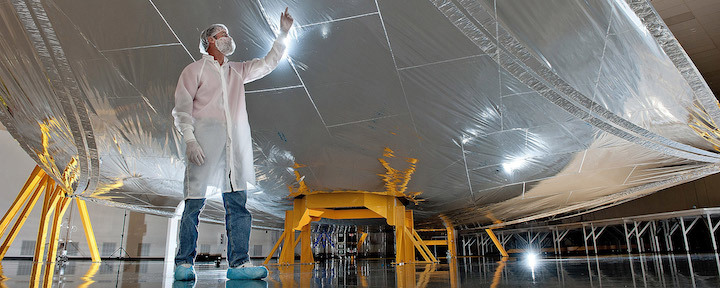
The National Aeronautics and Space Administration (NASA) leads an international partnership that includes the European Space Agency and the Canadian Space Agency. NASA’s Goddard Space Flight Center is managing the Webb Telescope project, and the Space Telescope Science Institute is responsible for science and mission operations, as well as ground station development.
As the prime contractor to develop the James Webb Space Telescope, Northrop Grumman will design and build the deployable sunshield, provide the spacecraft and integrate the total system. The observatory subsystems are developed by a Northrop Grumman-led team with vast experience in developing space-based observatories:
- Ball Aerospace: Optical design, mirrors, wavefront sensing, and control design and algorithms
- Harris Corporation: Optical telescope integration and testing
- University of Arizona: Near-Infrared Camera
- European Space Agency (ESA): Near-Infrared Spectrograph
- Jet Propulsion Laboratory (JPL), ESA: Mid-Infrared Instrument
- Canadian Space Agency (CSA): Fine Guidance Sensor with Tunable Filter Module
THE JWST ENGINEERS
The Northrop Grumman engineers behind the James Webb Space Telescope have no easy task. It has taken one hundred million hours of people’s lives to build the largest, most complex and powerful space telescope ever built. Hear from the engineers who take pride in what they’re accomplishing — writing the next chapters of space history.
ZURBUCHEN HINTS AT MORE JWST DELAYS
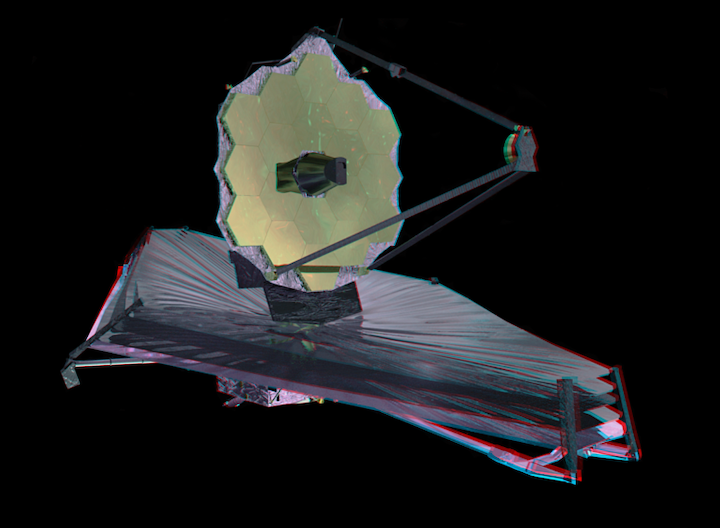
The head of NASA’s Science Mission Directorate hinted today that more delays may be in the offing for the James Webb Space Telescope (JWST). While progress is being made integrating the spacecraft and its instruments at prime contractor Northrop Grumman, Thomas Zurbuchen is worried about the time it is taking and an agency-level assessment is underway to determine whether the March 2021 launch date is realistic.
Zurbuchen provided an update on JWST to the Science Committee of the NASA Advisory Council (NAC) this morning. He recently visited Northrop Grumman and was impressed at the magnitude of the effort required to build the telescope, which is often described as the follow-on to the Hubble Space Telescope. JWST and Hubble study the universe in different bands of the electromagnetic spectrum (Hubble is primarily an optical telescope while JWST operates in the infrared), but both are designed to unravel the mysteries of the universe.
Originally envisioned in the late 1990s as a $1 billion telescope, by last year the cost had grown to $8.8 billion for development (not including operations). That breached a congressionally-imposed cost cap of $8 billion that was established in law after substantial cost growth and schedule delays in the early part of this decade. After rebaselining the program in 2011, NASA promised the telescope would launch in October 2018, but by late 2017 it was clear that date would not be met due to integration problems at Northrop Grumman.
NASA established an Independent Review Board (IRB), chaired by Tom Young, that concluded the earliest possible launch date was March 2021. NASA calculated the new development cost estimate at $8.803 billion, a 10 percent increase, which is surprising so late in a program. Adding in operations, the revised life cycle cost is $9.663 billion. The costs do not include launch. The European Space Agency agreed to launch JWST on an Ariane V rocket as part of a cooperative agreement with NASA at no cost to NASA. Canada is also a partner in the project.
The House Science, Space, and Technology Committee held a two-day hearing following the IRB report where Northrop Grumman bore the brunt of the committee’s displeasure. In the end, however, Congress increased the cap to $8.8 billion considering that $7 billion had been spent already and the scientific potential of the data JWST will produce is indisputable.
The mantra became “Webb is worth the wait.”
The IRB report spelled out what had gone wrong and what needed to be done to ensure the telescope works properly once it is launched. There are no second chances for JWST. Unlike Hubble, JWST is not designed to be serviced by astronauts (or robots) and will not be located in Earth orbit. It is headed to the Sun-Earth L2 Lagrange point 1 million miles (1.5 million kilometers) away.
That was Zurbuchen’s point this morning. In a recent visit to Northrop Grumman where JWST passed a sunshield deployment test, he was impressed at the progress being made, but cited “close to a dozen issues that we’re working.”
“My worry at this moment in time is just the time we’re taking. … Our March ’21 launch date is the launch date that we’re heading towards and we’re currently in the process of our agency-level assessment of that to really see how likely that launch date is and … beyond that, financial reserves and so forth.
I know if you are an astrophysicist you want us to absolutely test this spacecraft absolutely well [and not] launch in March [2021] with problems. — Thomas Zurbuchen
In an email this afternoon, a NASA spokesperson told SpacePolicyOnline.com that although “issues have been revealed during testing that have reduced the schedule margin,” NASA continues to work towards the March 2021 launch date. “Mission success depends on rigorous testing.” NASA is “confident” in the success of JWST and there are no plans to reconvene the Independent Review Board.
Quelle: SPACEPOLICYONLINE.COM
----
Update: 31.12.2019
.
What's the Point of the James Webb Space Telescope?
The oft-delayed space observatory will be worth the wait.
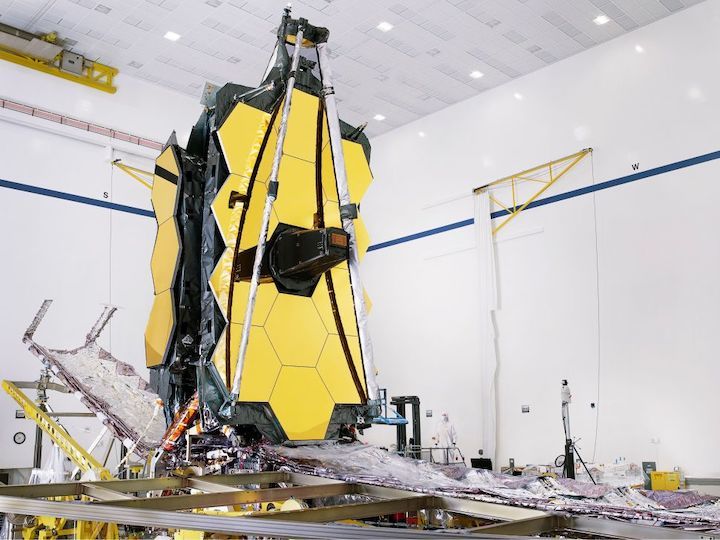
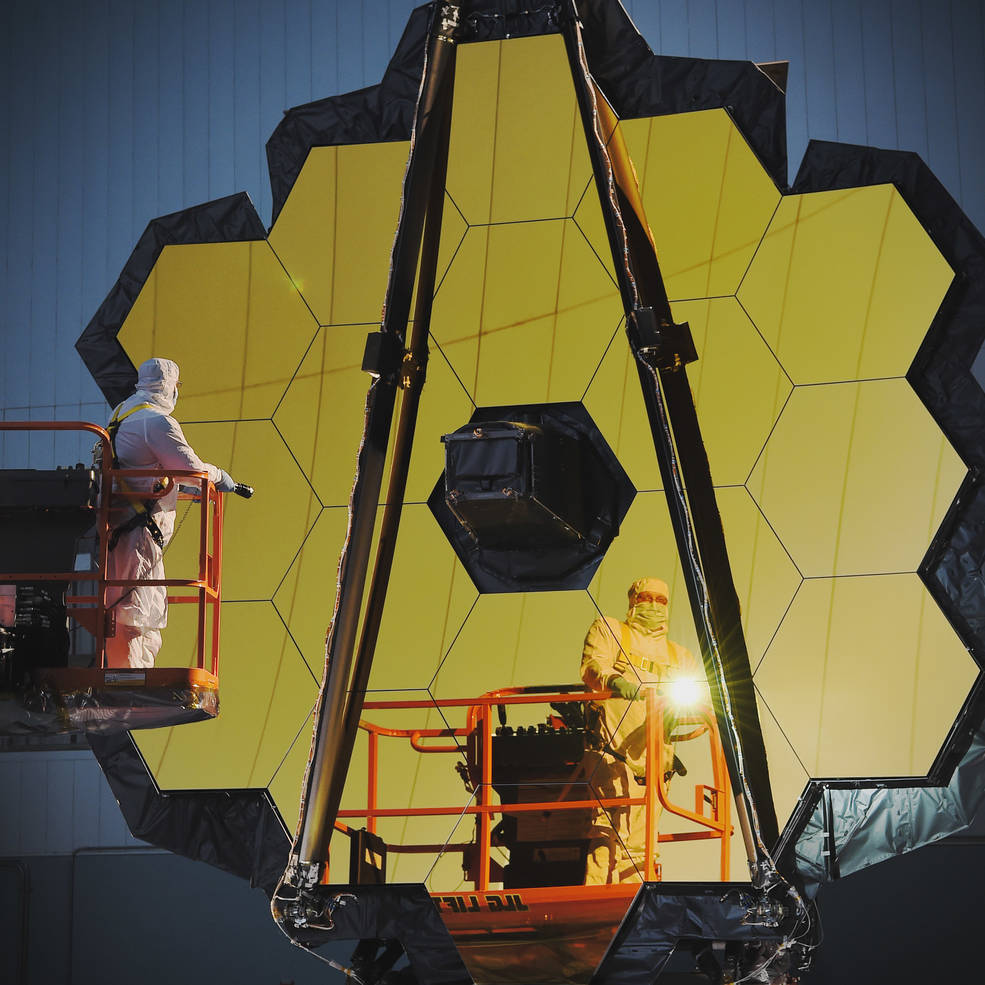
Paul M. Sutter is an astrophysicist at The Ohio State University, host of Ask a Spaceman and Space Radio, and author of "Your Place in the Universe." Sutter contributed this article to Space.com's Expert Voices: Op-Ed & Insights.
NASA's James Webb Space Telescope is (currently) scheduled to launch in March of 2021, after years of delays and billions of dollars spent over budget. While it's easy to argue that all that time and money has been wasted, this observatory will be the premiere and undisputed champion of infrared wavelengths, giving us unparalleled access to corners of the universe currently inaccessible.
If we want to learn new things about everything from the first galaxies to the chance for life on other planets, the roughly $9.7 billion James Webb is our only hope.
No chill
While the James Webb Space Telescope ("JWST" to those in the know) is heralded as the "successor" to NASA's storied Hubble Space Telescope, it kind of isn't. The Hubble is primarily an optical telescope, capturing wavelengths of light similar to the range that the human eye does, and extending past that a little bit into the infrared and ultraviolet (UV) portions of the electromagnetic spectrum. In essence, the Hubble is a giant orbiting space eyeball, delivering stunning pictures that you would see, if your optic nerves were similarly equipped.
But the JWST is different. It will be observing entirely in the infrared, barely scratching the deepest possible reds that a human can see. In other words, the JWST will be studying a universe that is largely invisible to human experience.
One of the major reasons that the JWST is designed to be an infrared scope is that infrared astronomy is, in general, really hard to do from the surface of the Earth. Light pollution is the bane of astronomers, who need their skies crystal-clear and perfectly dark to do their detailed observations and measurements.
And infrared light pollution comes from many different places. Basically, anything warm. Which is, basically, everything. Human bodies generate 100 watts of infrared radiation. The Earth itself is pretty warm, glowing strongly in infrared bands. Even the telescope itself, if it's at room temperature, is aglow in the infrared.
It's not that we can't do infrared astronomy from the ground, it's just that it's frustratingly hard.
Far from home
The JWST will operate about 1 million miles (1.5 million kilometers) from the Earth, to get it safely far away from our warm, infrared-glowing planet. But even still, there's the sun to contend with. Ever sit outside on a nice summer day, feeling the warmth of our sun on your skin? Yeah, that's infrared radiation, pumped out by the bucketful. And even a million miles away from the Earth, the sun is still a little bit toasty.
To combat this, designers of infrared space telescopes have a couple options. The most common choice is to use an active cooling system, chilling down the telescope to the temperatures needed to properly observe infrared wavelengths. This is great, and utilized by previous infrared space telescopes, but it does limit their lifespans. No more coolant = no more astronomy.
So instead the JWST will deploy a giant, expensive space umbrella, 72 feet (22 meters) long and 36 feet (11 m) wide, made of five layers of extremely reflective material, each layer thinner than a human hair. This massive "sunshield" will keep the telescope itself in constant shade, somewhere south of minus 370 degrees Fahrenheit (minus 223 degrees Celsius), which is ideal for the infrared wavelengths it will be studying.
Although, just for fun, one of the instruments onboard will be chilled with an active cooling system to below minus 433 Fahrenheit (minus 258 C ), which will allow it to access some even longer infrared wavelengths.
Behold the science
All in all, the JWST is massive. In fact, it's so big that it shouldn't be able to fit on a rocket. Besides the gargantuan sunshield, the primary mirror will be 21 feet (6.5 m) across, which is far wider than any rocket fairing currently in use. Duct-taping the mirror to the side of the rocket isn't exactly a workable solution, so instead the clever NASA engineers broke the mirror into 18 smaller hexagonal sections, which will be tucked and folded into the rocket (along with the folded-up sunshield and the rest of the telescope itself).
If everything goes right, just a few days after launch the JWST will head to its observing point, unfold, and start staring.
And what it will see will be — and I'm not using this word lightly — remarkable. One of its main targets will be the early universe, when our cosmos was just a few hundred million years old. The first stars and galaxies to appear on the cosmic scene blazed brightly in the visible spectrum, but over the course of the past 13 billion years the universe has expanded, stretching that light out of the visible range and down into the infrared — right in the sweet spot of the JWST's design parameters.
Since we have no images at all from the epoch of the first stars and galaxies (known colloquially as the "cosmic dawn") this will be our first-ever view into this important age in the history of the cosmos.
Closer to home, the JWST will study anything cool in the cosmos, from protoplanetary disks around newborn stars to molecular clouds, comets, Kuiper Belt objects and more.
And JWST will use a specialized device to block out light from some distant stars, enabling the observatory to snap pictures of any objects orbiting those stars — like exoplanets. Those planets will be glowing in the infrared, and the light from those planets will be modified by the chemicals and elements in their atmospheres, chemicals and elements which might be signs of life.
From ET hunter to cosmic-dawn revealer, the JWST will certainly be worth the wait.
Quelle: SC
----
Update: 9.01.2020
.
JWST remains on schedule for March 2021 launch
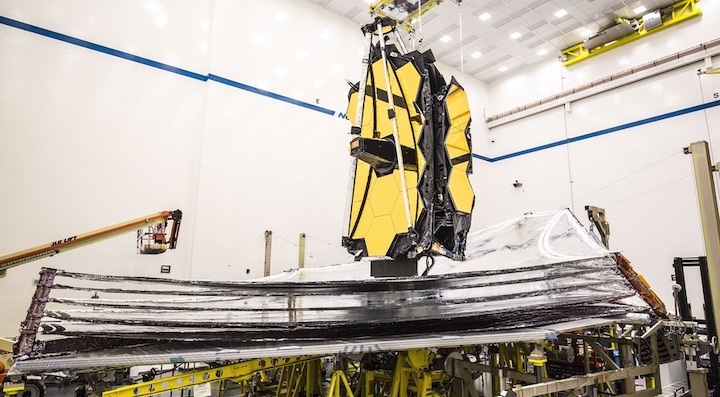
HONOLULU — Despite a limited amount of schedule reserve remaining, both NASA and Northrop Grumman are cautiously optimistic that the James Webb Space Telescope will remain on schedule for launch in March 2021.
During a town hall about the mission during the 235th Meeting of the American Astronomical Society here Jan. 5, Eric Smith, program scientist for JWST at NASA Headquarters, told astronomers that work testing the giant space telescope was going well, even though only two months of margin remain in the schedule through its launch next year.
“Although the schedule margin looks a little tight up there,” he said, referring to a schedule chart for the mission, “we do remain within our budget and we are planning to the March 2021 launch readiness date.”
In interviews here Jan. 6, officials from both NASA and Northrop Grumman, the prime contractor for JWST, reiterated that confidence. “The path is to deliver the telescope by the end of 2020,” said Scott Willoughby, vice president and program manager for JWST at Northrop Grumman. The telescope will then be shipped from Northrop’s facilities in Southern California to Kourou, French Guiana, where it will be prepared for launch on an Ariane 5.
Workers are currently putting the telescope back into its folded launch configuration after recent deployment tests, as well as replacing two electronics units on the spacecraft that technicians found last year had failed. The spacecraft will then undergo vibration and acoustics tests to simulate the launch environment.
Those tests will be followed by a final set of deployments of the spacecraft’s sunshield. There will also be tests to confirm the ability to command the spacecraft from JWST’s mission operations center at the Space Telescope Science Institute in Maryland. That will be followed by “final configuration” of the spacecraft to prepare it for shipment to the launch site.
Willoughby said his confidence was based on the fact that many of the remaining tests, including deployments and environmental testing, have been done before. “All of the work that’s planned in front of us is very well understood,” he said. “If everything goes as planned, the schedule is very much sufficient to get us there.”
He also credited the progress the company made on JWST in the last year. “2019 was as successful of a year on this program as you probably could have imagined in the history of it,” he said. “I think that’s a great foretelling of 2020.”
Greg Robinson, the JWST program director at NASA Headquarters, is also optimistic about staying on schedule. “Hopefully by the end of the year we’ll take this baby over to Long Beach and put it on a boat and send it to Kourou,” he said in a separate interview.
Robinson acknowledged that schedule is the primary concern for JWST at this point, and that the schedule will be reassessed in May prior to the final set of environmental tests. NASA also has to inform the European Space Agency about 12 months in advance of the launch so that it can begin its launch preparations, but Robinson said that formal notice doesn’t have to come exactly a year before the launch, and that ESA is being kept in the loop about NASA’s plans.
Last year, Tom Young, the retired aerospace executive who chaired the independent review board that examined JWST, warned that the it appeared the program was consuming schedule margin at a high rate. Robinson said that, since then, the use of schedule margin has declined.
“In the second half of 2019, schedule erosion has diminished significantly, and that’s what gives us a lot of confidence to still press to that March 2021 launch date,” he said.
Robinson also said there were “no major concerns” about the budget for the mission. JWST received $423 million in the fiscal year 2020 spending bill enacted last month, and he said the mission was comfortably within its revised cost cap of $8.8 billion.
As work on the spacecraft itself continues, preparations are underway for planning observations once in space. The Space Telescope Science Institute, which will manage JWST operations, plans to release a “Cycle 1” call for proposals Jan. 23. Proposals will be due May 1, with the institute making selections later in the summer.
At the town hall meeting, institute officials said they expect to receive 1,000 to 1,600 proposals, seeking some fraction of the 6,000 hours of observing time that will be available in that initial round of observations. About 300 proposals will be selected for Cycle 1, which will begin once spacecraft commissioning is complete about six months after launch.
Quelle: SN
----
Update: 14.01.2020
.
New Technique May Give NASA's Webb Telescope a Way to Quickly Identify Planets with Oxygen
Columbia MD and Washington DC--January 6, 2020. Researchers may have found a way that NASA's James Webb Space Telescope can quickly identify nearby planets that could be promising for our search for life, as well as worlds that are uninhabitable because their oceans have vaporized.
Since planets around other stars (exoplanets) are so far away, scientists cannot look for signs of life by visiting these distant worlds. Instead, they must use a cutting-edge telescope like Webb to see what's inside the atmospheres of exoplanets. One possible indication of life, or biosignature, is the presence of oxygen in an exoplanet’s atmosphere. Oxygen is generated by life on Earth when organisms such as plants, algae and cyanobacteria use photosynthesis to convert sunlight into chemical energy.

But what should Webb look for to determine if a planet has a lot of oxygen? In a new study, researchers identified a strong signal that oxygen molecules produce when they collide. Scientists say Webb has the potential to detect this signal in the atmospheres of exoplanets.
“Before our work, oxygen at similar levels as on Earth was thought to be undetectable with Webb, but we identify a promising way to detect it in nearby planetary systems,” said Universities Space Research Association’s Thomas Fauchez at NASA’s Goddard Space Flight Center in Greenbelt, Maryland. “This oxygen signal is known since the early 80’s from Earth’s atmospheric studies, but has never been studied for exoplanet research.” Fauchez is the lead author of the study, appearing in the journal Nature Astronomy.
The researchers used a computer model to simulate this oxygen signature by modeling the atmospheric conditions of an exoplanet around an M dwarf, the most common type of star in the universe. M dwarf stars are much smaller, cooler, and fainter than our Sun, yet much more active, with explosive activity that generates intense ultraviolet light. The team modelled the impact of this enhanced radiation on atmospheric chemistry, and used this to simulate how the component colors of the star's light would change when the planet would pass in front of it.
As starlight passes through the exoplanet’s atmosphere, the oxygen absorbs certain colors (wavelengths) of light— in this case, infrared light with a wavelength of 6.4 micrometers. When oxygen molecules collide with each other or with other molecules in the exoplanet’s atmosphere, energy from the collision puts the oxygen molecule in a special state that temporarily allows it to absorb the infrared light. Infrared light is invisible to the human eye, but detectable using instruments attached to telescopes.
“Similar oxygen signals exist at 1.06 and 1.27 micrometers and have been discussed in previous studies but these are less strong and much more mitigated by the presence of clouds than the 6.4 micrometer signal,” said Geronimo Villanueva, a co-author of the paper at Goddard.
Intriguingly, oxygen can also make an exoplanet appear to host life when it does not, because it can accumulate in a planet’s atmosphere without any life activity at all. For example, if the exoplanet is too close to its host star or receives too much star light, the atmosphere becomes very warm and saturated with water vapor from evaporating oceans. This water could be then broken down by the strong ultraviolet radiation into atomic hydrogen and oxygen. Hydrogen, which is a light atom, escapes to space very easily, leaving the oxygen behind.
Over time, this process can cause entire oceans to be lost while building up a thick oxygen atmosphere. So, abundant oxygen in an exoplanet’s atmosphere does not necessarily mean abundant life, but may instead indicate a rich water history.
“Depending upon how easily Webb detects this 6.4 micrometer signal, we can get an idea about how likely it is that the planet is habitable,” said Ravi Kopparapu, a co-author of the paper at Goddard. “If Webb points to a planet and detects this 6.4 micrometer signal with relative ease, this would mean that the planet has a very dense oxygen atmosphere and may be uninhabitable.”
The oxygen signal is so strong that it also can tell astronomers whether M dwarf planets have atmospheres at all, using just a few Webb transit observations.
“This is important because M dwarf stars are highly active, and it has been postulated that stellar activity might ‘blow away’ entire planetary atmospheres,” said Fauchez. “Knowing simply whether a planet orbiting an M dwarf can have an atmosphere at all is important for understanding star-planet interactions around these abundant but active stars.”
Although the oxygen signal is strong, cosmic distances are vast and M dwarfs are dim, so these stars will have to be relatively nearby for Webb to detect the signal in exoplanet atmospheres within a reasonable amount of time. An exoplanet with a modern Earth-like atmosphere will have to be orbiting an M dwarf that is within approximately 16 light-years of Earth. For a desiccated exoplanet with an oxygen atmosphere 22 times the pressure of Earth’s, the signal could be detected up to about 82 light-years away. One light-year, the distance light travels in a year, is almost six trillion miles. For comparison, the closest stars to our Sun are found in the Alpha Centauri system a little over 4 light-years away, and our galaxy is about 100,000 light-years across.
The research was funded in part by Goddard’s Sellers Exoplanet Environments Collaboration (SEEC), which is funded in part by the NASA Planetary Science Division's Internal Scientist Funding Model. This project has also received funding from the European Union’s Horizon 2020 research and innovation program under the Marie Sklodowska-Curie Grant, the NASA Astrobiology Institute Alternative Earths team, and the NExSS Virtual Planetary Laboratory.
Webb will be the world's premier space science observatory, when it launches in 2021. It will solve mysteries in our solar system, look beyond to distant worlds around other stars, and probe the mysterious structures and origins of our universe and our place in it. Webb is an international project led by NASA with its partners, ESA (European Space Agency) and the Canadian Space Agency.
Quelle: USRA
----
Update: 30.01.2020
.
NASA’s next big space observatory will likely miss its target launch date — again
A new audit suggests there’s very little wiggle room
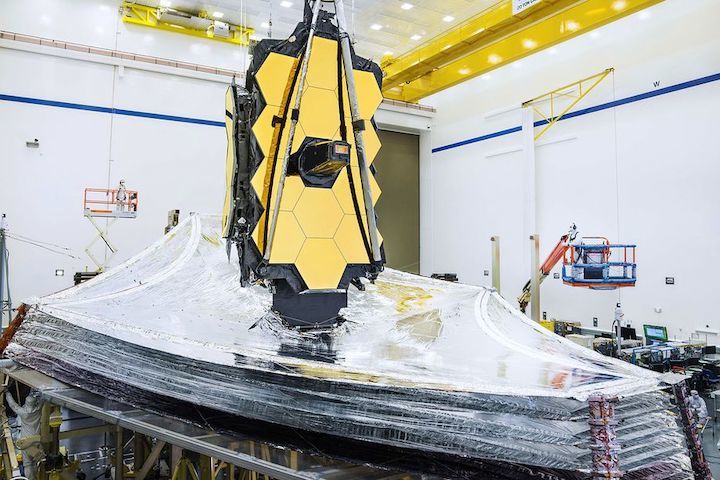
NASA’s next big space observatory — the James Webb Space Telescope — probably won’t launch in March 2021, potentially creating added costs for the long-delayed and over-budget program. Unforeseen technical problems are prolonging the process of finishing up the telescope, making it increasingly likely that the spacecraft will have to launch at a later date.
The grim news is detailed in the latest report from the Government Accountability Office(GAO), which performs audits of federally run programs. The GAO, which has been keeping a watchful eye on the telescope’s development for years, claims that there is only a 12 percent chance the agency will meet its March 2021 goal, thanks to a recent analysis done in October by those working on the program. NASA will figure out a new date in the spring of this year, according to the audit.
A delay would be just the latest hiccup in a long, troubled history for the James Webb Space Telescope, or JWST. When it was first being conceived in the 1990s, JWST was thought to cost somewhere between $1 billion and $3.5 billion, and scientists expected it to launch between 2007 and 2011. Since then, the costs skyrocketed, shooting up by 95 percent as the launch date has slipped further (and further) into the future. NASA now expects the total development and operational costs of JWST to run $9.66 billion.
The GAO claims that Northrop Grumman, the main contractor on JWST, has come a long way over the last year, and made significant milestones as it readies the observatory for launch. However, Northrop has eaten up most of the reserve schedule it had budgeted when planning out the timeline for the next couple of years, and now only has less than a quarter of that buffer time left. The contractor has done some work to get that schedule reserve back, but there’s very little margin for error.
Technical issues are to blame for eating up all this precious time, a long-standing problem for Northrop Grumman as it’s been piecing together JWST. Testing in 2018 caused some screws and washers to come lose on the spacecraft, and Northrop Grumman accidentally caused tears in the vehicle’s sun shield, a delicate piece of hardware needed to keep the telescope cool in space. Most recently in 2019, testing revealed powering issues with two important spacecraft components. The contractors have addressed the failures, but these mounting technical challenges have caused the workforce to work longer than expected, which may lead to increased costs for the program.
It’s unclear exactly how much a delay will run NASA at this point. NASA indicated to the GAO that it has enough funding to support a delay of three to four months beyond the March 2021 date. However, the extra work required of Northrop Grumman’s workforce may lead to significant cost overruns.
The GAO isn’t making any recommendations with its report, so it’s possible there may not be much that NASA can do at this point to keep things on track. In response to the audit, NASA argued that the telescope has met a lot of milestones in 2019, and that the year ahead will be extremely busy, too. In 2020, the observatory will go through a series of environmental testing to ensure it can survive in the harsh vacuum of space. That testing should last until November, according to the space agency.
“We’ve reduced a lot of risk, but there are still technical challenges ahead to prepare this very complex observatory for launch,” Gregory Robinson, the program director for the James Webb Space Telescope, said in a statement to The Verge. “While the schedule for the March 2021 launch readiness date is tight, we are still planning toward that, without any changes to the budget. The schedule will be reviewed again in May 2020.”
Despite the turmoil it’s been through, JWST is still a massive priority for the astronomy community. Once complete and launched, it’ll garner the title of the most powerful space observatory ever built. The telescope, which will be situated 1 million miles from Earth, sports a giant gold mirror that spans 21 feet (6.5 meters) across, allowing the observatory to see some of the oldest, most distant objects in the Universe. It will essentially allow astronomers to peer back in time to when the Universe first burst into being 13.8 billion years ago. So while the delays have been frustrating, NASA and the astronomy community still want to see the project through.
Quelle: The Verge
----
Update: 3.04.2020
.
In a recent test, NASA’s James Webb Space Telescope fully deployed its primary mirror into the same configuration it will have when in space.
As Webb progresses towards liftoff in 2021, technicians and engineers have been diligently checking off a long list of final tests the observatory will undergo before being packaged for delivery to French Guiana for launch. Performed in early March, this procedure involved commanding the spacecraft’s internal systems to fully extend and latch Webb’s iconic 21 feet 4-inch (6.5 meter) primary mirror, appearing just like it would after it has been launched to orbit. The observatory is currently in a cleanroom at Northrop Grumman Space Systems in Redondo Beach, California.
The difficulty and complexity of performing tests for Webb has increased significantly, now that the observatory has been fully assembled. Special gravity offsetting equipment was attached to Webb’s mirror to simulate the zero-gravity environment its mechanisms will have to operate in. Tests like these help safeguard mission success by physically demonstrating that the spacecraft is able to move and unfold as intended. The Webb team will deploy the observatory’s primary mirror only once more on the ground, just before preparing it for delivery to the launch site.
A telescope’s sensitivity, or how much detail it can see, is directly related to the size of the mirror that collects light from the objects being observed. A larger surface area collects more light, just like a larger bucket collects more water in a rain shower than a small one. Webb’s mirror is the biggest of its kind that NASA has ever built.
In order to perform groundbreaking science, Webb’s primary mirror needs to be so large that it cannot fit inside any rocket available in its fully extended form. Like the art of origami, Webb is a collection of movable parts employing applied material science that have been specifically designed to fold themselves to a compact formation that is considerably smaller than when the observatory is fully deployed. This allows it to just barely fit within a 16-foot (5-meter) payload fairing, with little room to spare.
“Deploying both wings of the telescope while part of the fully assembled observatory is another significant milestone showing Webb will deploy properly in space. This is a great achievement and an inspiring image for the entire team,” said Lee Feinberg, optical telescope element manager for Webb at NASA’s Goddard Space Flight Center in Greenbelt, Maryland.
The evolving novel coronavirus COVID-19 situation is causing significant impact and disruption globally. Given these circumstances, Webb’s Northrop Grumman team in California has resumed integration and testing work with reduced personnel and shifts until the Deployable Tower Assembly set up in April. The project will then shut down integration and testing operations due to the lack of required NASA onsite personnel related to the COVID-19 situation. The project will reassess over the next couple of weeks and adjust decisions as the situation continues to unfold.
The James Webb Space Telescope will be the world’s premier space science observatory when it launches in 2021. Webb will solve mysteries in our solar system, look beyond to distant worlds around other stars, and probe the mysterious structures and origins of our universe and our place in it. Webb is an international program led by NASA with its partners, ESA (European Space Agency) and the Canadian Space Agency.
Quelle: NASA
----
Update: 16.04.2020
.
NASA’s James Webb Space Telescope Completes Primary Mirror Test
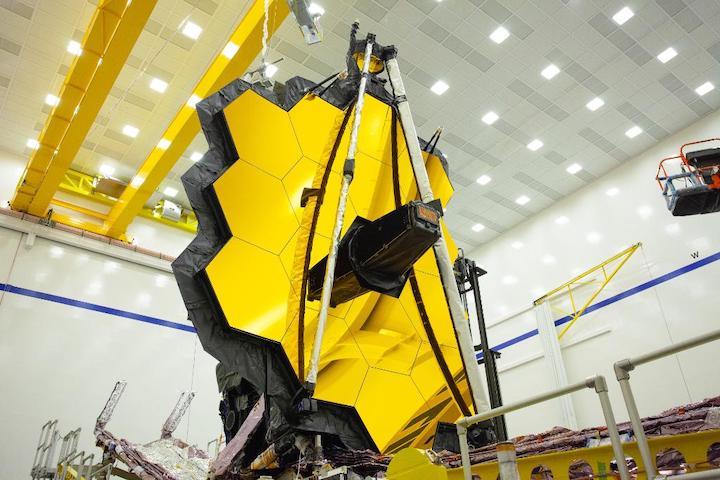
Northrop Grumman Space Systems has successfully completed the deployment of the Primary Mirror on NASA’s next-generation space telescope, the James Webb Space Telescope.
During the deployment test, Northrop Grumman personnel instructed the spacecraft to deploy – and then securely latch – the Primary Mirror to the position which it will need to be in to conduct science. The Primary Mirror will only be deployed once more – and that’ll be before shipment to the launch site.
The Primary Mirror is 21 feet and 4 inches across. The mirror on the James Webb Space Telescope is the largest ever built for NASA. The mirror has a diameter 2.7 times the size of the one on the Hubble Space Telescope.
The reason that the Mirror folds on the telescope is that when deployed, the mirror is too large to fit inside of the 16 foot payload fairing during launch. On the Primary Mirror, there are two “wings,” one on the left and the other on the right. Each wing has to deploy for the telescope to operate properly.
Deploying the Primary Mirror on the ground is complex for Northrop Grumman. This is because they have to simulate a zero gravity environment to check that the telescope can operate in space.



